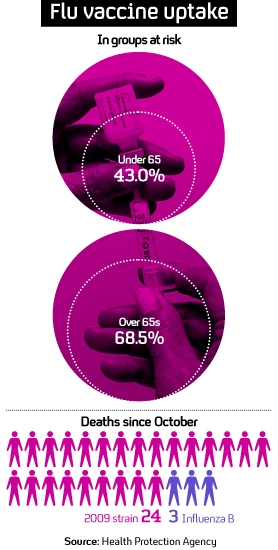Intensive care flu cases soar as 24 die from swine flu
There are 460 people in intensive care across Britain with confirmed or suspected flu – more than twice as many people as there were a week ago.
Department of Health statistics show 182 people were receiving intensive treatment for flu on 15 December, whereas today that figure has surged to 460.
But the DoH said the new figures are in accordance with seasonal expectations.
On Wednesday the Health Protection Agency announced 27 people had died from flu this winter, including nine children. Of those cases, 24 had swine flu.
Almost half of those who died were in an at-risk group, suffering from ailments such as diabetes, heart disease or asthma.
Commenting on the swine flu figures, Dr Alan McNally, a molecular biologist from Nottingham Trent University, said: “What you are now seeing is last year’s pandemic virus, which was referred to as swine flu, is going what it would be expected to do if you were an influenza biologist.
“It’s come back as what is now normal seasonal flu.”
But he acknowledged there was concern over the number of people in intensive care. “I think it comes down to the fact that this time last year, the uptake of the vaccine wasn’t as strong as it should have been.”
H1N1 means we're not seeing a "normal" winter flu season
Flu kills. Flu puts people in hospital. Every winter. Superficially, this year is no different, writes Channel 4 News Science Correspondent Julian Rush.
But look behind the numbers and there's a story.
The timing and the numbers for this winter's recent rise in flu cases is, on the face of it, nothing out of the ordinary.
But because the main strain that's going around is H1N1 - "swine flu" - we're not seeing a "normal" winter flu season.
To some extent, H1N1 is behaving like a traditional seasonal flu, but it remains a relatively new strain. That means the people who fall ill aren't the traditional flu victims - the very old, the very young, the very weak.
As we discovered when H1N1 first visited these shores in the summer of 2009, it finds its victims among the young who have no immunity. Most, because they're fit and healthy, suffer relatively mild illness.
So there's an unusual bulge in the numbers. As of 23 December, 460 people were in critical care beds in England. 366 were in the 16-64 age group.
That can be explained, in part, because that age group makes up the biggest proportion of the population.
But they're also the largest group of people who aren't normally vaccinated (this winter's seasonal flu vaccine includes H1N1).
Within this group of 16 to 64-year-olds is a sub-group of people at risk - people with immune problems, asthma, kidney disease etc. And that sub-group is not small: it includes - for the first time - pregnant women, who are three to four times at greater risk of severe illness.
The vaccination take-up rate among this at-risk sub-group is only 43 per cent, and that's causing concern among health officials because they know they're the people who are most likely to get ill this winter and there's a lot of them.

Health Secretary Andrew Lansley denied this year’s lower take-up for the flu vaccine among the younger, at-risk groups, such as pregnant women, was the result of the government’s failure to run an advertising campaign.
“We know who are the groups that we need to call for vaccination. That’s what we are doing with the general practitioners,” he told BBC Radio.
“We are focusing on insuring that we do actually reach the people who need vaccination.”
However, shadow health secretary John Healey said Mr Lansley had made the “wrong judgement” by axing the advertising campaign. As a result, many people were without the flu protection they should have.
Mr Healey called on the Health Secretary to authorise “an immediate public advertising campaign to encourage those most at risk to get the flu jab”.
Vaccination rates are currently 86.5 per cent for the over-65s, compared with 70.4 per cent this time last year.
The vaccination rate for under-65s is 43 per cent, compared with 48.6 per cent at the end of 2009.